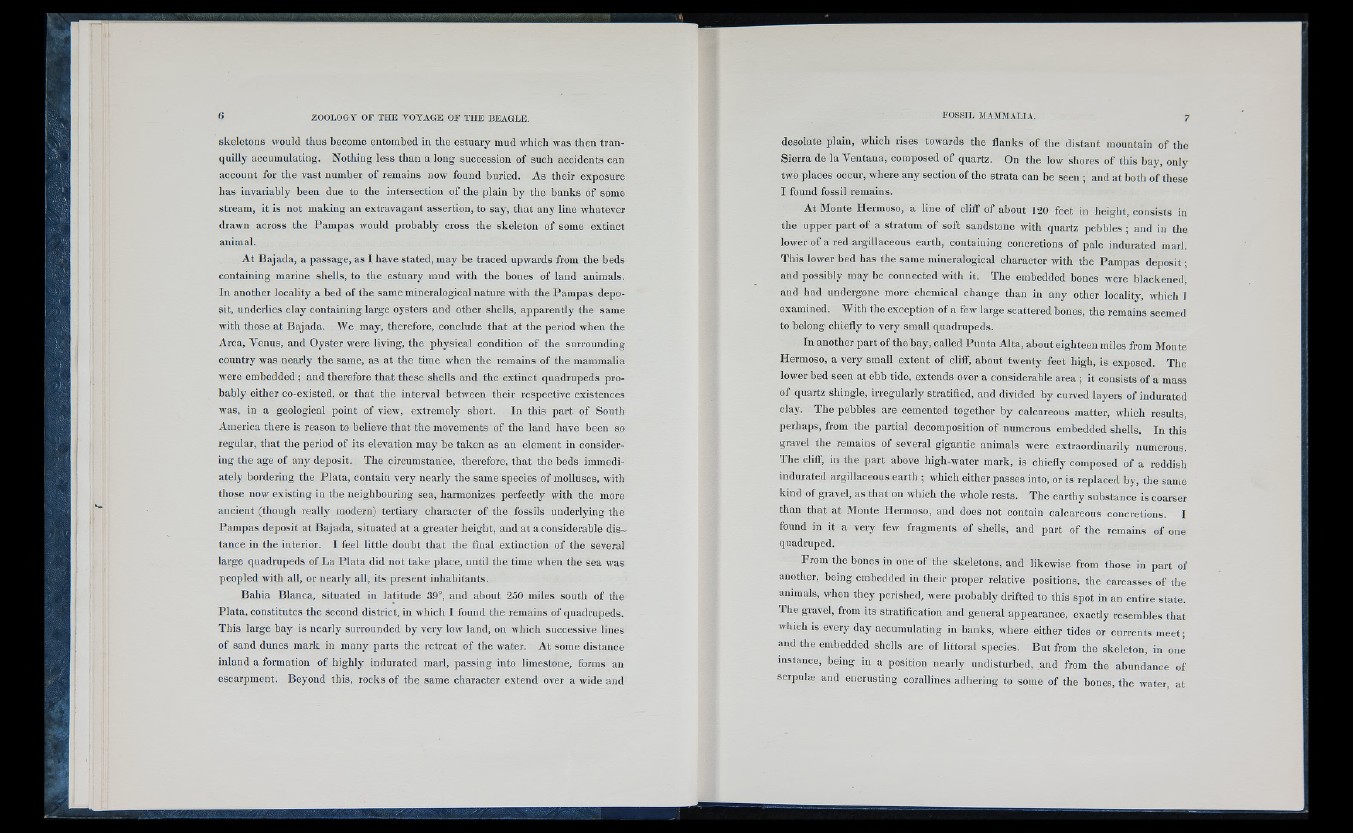
ske letons would thus become entombed in the estuary mud which was then tranquilly
accumulating. Nothing le ss than a long succession o f such accidents can
account for the vast number o f remains now found buried. A s their exposure
has invariably been due to the intersection o f the plain by the banks o f some
stream, it is not making an extravagant assertion, to say, that any line whatever
drawn across the Pampas would probably cross the skeleton o f some extinct
animal.
A t Bajada, a passage, as I have stated, may be traced upwards from the beds
containing marine shells, to the estuary mud with thé bones o f land animals.
In another locality a bed o f the same m ineralogical nature with the Pampas deposit,
underlies clay containing large oysters and other shells, apparently the same
with those at Bajada. We may, therefore, conclude that at the period when the
Area, Venus, and Oyster were living, the physical condition o f the surrounding
country was nearly the same, as at the time when the remains o f the mammalia
were embedded ; and therefore that these she lls and the extinct quadrupeds prob
ably either co-existed, or that the interval between their respective existences
was, in a geological point of view, extremely short. In this part o f South
America there is reason to believe that the movements o f the land have been so
regular, that the period o f its elevation may be taken as an element in considering
the age o f any deposit. The circumstance, therefore, that tlie beds immediately
bordering the Plata, contain very nearly the same spe cie s o f m olluscs, with
those now existing in the neighbouring sea, harmonizes perfectly with the more
ancient (though really modern) tertiary character of the fossils underlying the
Pampas deposit at Bajada, situated at a greater height, and at a considerable distance
in the interior. I feel little doubt that the final extinction o f the several
large quadrupeds o f La Pla ta did not take place, until the time when the sea was
peopled with all, or nearly all, its present inhabitants.
Bahia Blanca, situated in latitude 39°, and about 250 miles south o f the
Plata, constitutes the second district, in which I found the remains o f quadrupeds.
This large bay is nearly surrounded by very low land, on which successive lines
o f sand dunes mark in many parts the retreat o f the water. A t some distance
inland a formation o f highly indurated marl, passing into limestone, forms an
escarpment. Beyond this, rocks o f the same character extend over a wide and
desolate plain, which rises towards the flanks o f the distant mountain o f the
Sierra de la Ventana, composed o f quartz. On the low shores o f this bay, only
two places occur, where any section o f the strata can be seen ; and at both o f these
I found fossil remains.
At Monte Hermoso, a line o f cliff o f about 120 feet in lieigbt, consists in
the upper part o f a stratum o f soft sandstone with quartz pebbles ; and in the
lower o f a red argillaceous earth, containing concretions o f pale indurated marl.
This lower bed has the same mineralogical character with the Pampas d ep o sit;
and possibly may be connected with it. The embedded bones were blackened,
and had undergone more chemical change than in any other locality, which I
examined. With tlie exception o f a few large scattered bones, the remains seemed
to belong chiefly to very small quadrupeds.
In another part o f the bay, called Punta Alta, about eighteen m iles from Monte
Hermoso, a very small extent o f cliff, about twenty feet high, is exposed. The
lower bed seen at ebb tide, extends over a considerable area ; it consists o f a mass
o f quartz shingle, irregularly stratified, and divided by curved layers o f indurated
clay. The pebbles are cemented together by calcareous matter, which results,
perhaps, from the partial decomposition o f numerous embedded she lls. In this
gravel the remains o f several gigantic animals were extraordinarily numerous.
The cliff, in the part above high-water mark, is chiefly composed o f a reddish
indurated argillaceous earth ; which either passes into, or is replaced by, the same
kind o f gravel, as that on which the whole rests. The earthy substance is coarser
than that at Monte Hermoso, and does not contain calcareous concretions. I
found in it a very few fragments o f shells, and part o f the remains o f one
quadruped.
From the bones in one o f the skeletons, and likewise from those in part of
another, being embedded in their proper relative positions, the carcasses o f the
animals, when they perished, were probably drifted to this spot in an entire state.
The gravel, from its stratification and general appearance, exactly resembles that
which is every day accumulating in banks, where either tides or currents meet;
and the embedded shells are o f littoral species. But from the skeleton, in one
instance, being in a position nearly undisturbed, and from the abundance o f
serpulffi and encriisting corallines adhering to some o f the bones, the water, at